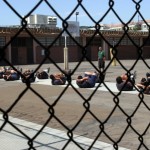There isn’t a silver bullet to how the system is able to sustain a decrease in rational disproportionality in King County. According to Chief Juvenile Court Judge Wesley Saint Clair, it’s a universe of things that keeps them on track.
“It’s a combination of programs like these and training our staff,” Saint Clair said. “Sometimes it’s about having a conversation about institutional racism, about privilege and bias within our staff. It’s not a single item.”
King County Deputy Prosecutor Jimmy Hung with the Juvenile Unit highlighted the Family Intervention & Restorative Services program. FIRS allows for the youth arrested for domestic violence to be entered into a 24/7 facility that provides them with family counseling, mental health services and drug and alcohol services. Since its launch last January, FIRS has decreased juvenile domestic violence cases by 62 percent.
Hung said:
The focus of this program is, instead of arresting kids from the home, taking them into detention and stripping them of their clothes, we bring them to our facility. The first question they get there is, ‘How are you doing? How can we help you?’
Best Starts for Kids is about to launch this year. It’s intended to support kids from birth to the age of 24 by providing parent support, health care, educational and employment support. Its strategic advisor Sheila Capestany says:
We’re about promotion, prevention and early intervention. We want to be able to turn around and set them up to better their lives. I always keep in mind the 80 year olds that would be able to say, ‘Boy, what a rough start in life, but the rest of it was great.’ We’re always thinking of what can we do now to make it their story.
A pilot program in Tukwila is coming this year that will focus on youth theft cases, using case management resources to hold youth accountable for their actions. The program is led by the Juvenile Justice Equity Steering Committee and funded through the $360 million Best Starts for Kids levy.
The 180 Program offers to drop charges for youth that choose to attend a workshop that helps them work through their life struggles and possibly be paired up with a mentor. More than 1,500 youth have been able to avoid charges by participating in the program since its launch in 2012.
Other programs include Creative Justice, Peacemaking Circles, Education and Employment Training, Juvenile Drug Court and Partnership for Youth Justice. What all these programs have in common is that they all try to focus on involving the community to help the troubled youth start a better life and become contributing community members.
Saint Clair said:
I would like to work myself out of the job. It’s because the work that we are doing is really the work that has to be embedded in the community. Institutions cannot do the work of restorative practice; we need to empower the community and delegate our authority to the community and be able to say these are all of our kids.
All levels of community are being engaged in the programs, from parents to teachers, and community leaders that come together to provide better services to youth that need it. However, one of the most crucial parts of this process is finding the right messengers that can speak the kids’ language.
Jason Clark, equity and social justice advocate for the juvenile court, says:
One of the most valuable things in this piece is incredible messengers. It’s the people that have been previously incarcerated and been able to get back into the society. We’ve got to have people in our community that speak the language of these kids and who understand the challenge of that transformation.
With these programs showing a lot of success, a question came up to the panel regarding the planned building of the new $210 million Children and Family Justice Center. The panelists were eager to weigh in on the issue.
Inveen had pointed out that money allocated for the courthouse comes from a levy, and can’t be diverted to any of the restorative justice and prevention programs. While the number of juvenile cases have been decreasing every year, there are still those that need to be detained, such as those charged with murder, sex offenses, robbery in first and second degree, and any crimes involving the use of firearms.
Saint Clair said the new detention center is also meant to accommodate youth that are currently being held in an adult jail and charged as adults. Also, the current facility does not hold the newly shaped stance on juvenile detention.
“[The current] detention facility was built in a time when we as a society were more punishment focused versus rehabilitation,” Hung said. “This gives us a prime opportunity to provide humane conditions for the employees, for youth to be provided with holistic services, and have space that has a lot of natural light and fresh air.”
“We want to know what the community wants to see within those walls, but it’s currently 3-4 years down the road in planning,” Inveen said. “The thought was to not identify the uses of the [space provided via reduction from 140 to 112 beds] now and waiting closer to opening the doors of the center.”
The panel ended on a positive note about the aspirational goal to reach a zero-detention rate within the juvenile justice system.
“I embrace the challenge,” Hung said. “If you look at other developed countries like Japan, they basically have achieved zero detention. We are truly one of the greatest countries in the world, and I think we can do it. It’s going to take more than what we do in our system; it’s the community as well. It’s something we all aspire to.”
© Humane Exposures / Susan Madden Lankford










